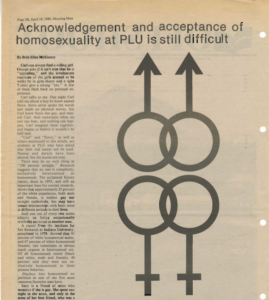A Queer History Timeline
Click through the timeline below. Scroll to the bottom of the page to continue through the exhibit.
A glimpse into queer history

The Mast interviews two queer students anonymously to underscore the anti-queer environment of the university in 1980.
The question I came to this project with was, how and why have PLU’s attitude towards queerness changed in recent decades? This project, including this timeline, is an attempt to map out some of the forces (internal and external) that influenced these changes. As a queer student at PLU from 2017-2022, I didn’t encounter the same level of institutional and interpersonal anti-queer bias that was prevalent on campus in the 1980s, for example. As Pastor Jen recounts in her story, it’s important to pay tribute to the people who loved, taught, and fought for these changes to occur. The more embracing and affirming environment on campus today wasn’t inevitable — it was the result of a huge network of local, national, and global forces pushing to combat queerphobia.
In addition, PLU’s attitudes towards queerness have been influenced by two other major factors — the shift in the Evangelical Lutheran Church of America’s (ELCA’s) official position on homosexuality (explained in this timeline) and the gradual de-Lutheranizing of campus itself. In 1990, roughly 36% of PLU’s undergraduates identified as Lutheran; in 2022, that number was down to 10%. While the university remains a Lutheran higher education institution, its Lutheran identity has morphed as it embraces a more diverse student body and as the ELCA becomes more liberal.
In the 1980s, just before this timeline begins, queerness on campus was a subject of curiosity for students — but not something that could be discussed openly. (For more on the PLU campus climate in the 80s, see Colleen’s story.) In this edition of The Mast from 1980, two queer students went on the record anonymously in hopes of demystifying their “lifestyle” for campus. Most other student coverage of queerness throughout the decade was negative, reminding students that it had no place at a Christian institution. Fast forward through thirty years and a series of intense debates on queerness also taking place in The Mast, and we reach today’s campus. While PLU, like all institutions, isn’t a flawless environment for our queer community, it has now dedicated structures, policy, and personnel to supporting queer Lutes, and boasts a thriving queer student scene.
These are the stories of the people who made this happen.


